[This is a long post.]
 The quotes in this post are from Beacon Lights of History: Great Writers by John Lord (©1896). The edition I read was published by WM. H. Wise & Co. in 1921. It's an erudite biography with quotes, remarks, opinions, and facts all delivered mostly in a conversational tone, but sometimes with extremely dry asides that are, maybe unintentionally, hilarious.
The quotes in this post are from Beacon Lights of History: Great Writers by John Lord (©1896). The edition I read was published by WM. H. Wise & Co. in 1921. It's an erudite biography with quotes, remarks, opinions, and facts all delivered mostly in a conversational tone, but sometimes with extremely dry asides that are, maybe unintentionally, hilarious.
"Perhaps one test of a great book is the pleasure derived from reading it over and over again. Measured by this test, the novels of Sir Walter Scott are among the foremost works of fiction, which have appeared in our world."
Sir Walter Scott is said to be the father of the modern novel and the father of the historical fiction novel. His books were termed Romances, not in the popular meaning of romance novels, but rather stemming from the French word roman, meaning novel.
John Lord in his Beacon Lights was openly admiring of Scott: "He who could charm millions of readers, learned and unlearned, for a quarter of a century, must have possessed a remarkable genius."
Childhood
A trip to his grandmother's house in the Border Lands of Scotland in his early childhood, introduced Scott to many of the tales, ballads, and legends that went on to become a lifelong passion for him. "As a youth, he devoured everything he could find pertaining to early Scottish poetry and romance, of which he was passionately fond. he was also peculiarly susceptible to the beauties of Scottish scenery..."
By the time, Scott graduated from University, he was fluent (in literary and colloquial) French, Italian, and German and literary Latin. In addition, he was a dedicated student of philosophy and Scottish Law (current and antiquarian). He'd written verses in Latin and English and translated books from German and Italian into English. Despite this, Lord wrote, "On the whole, he was not a remarkable boy, except for his notable memory (which, however, kept only what pleased him), and his very decided bent toward the poetic and chivalric in history, life, and literature."
Personality
"Great lawyers and great statesmen are rarely so egoistical and conceited as poets, novelists, artists, and preachers."
But according to Lord, Scott was sweet-tempered, merry, generous, cheerful, witty, modest, unpretentious, bright, and well-beloved. He was also a brilliant storyteller and a good sportsman, yet he was peremptory and pertinacious in pursuit of his own ideas. Admist great fame and prosperity, he never lost his "intellectual balance," his habitual modesty, or his work ethic.
"He praised all literary productions except this own. His most striking peculiarity was his good sense, keeping him from all exaggerations, which was always offensive to him."
Profession
Scott was a solicitor by day and a writer by night. He assiduously attended to his duties in the Courts, but "No man can serve two masters." Scott's heart was not in lawyering, but in writing about the beauty of Scotland—the land, its people, its culture, and its politics.
Prodigious Interests
Other than poetry and long fiction, Scott wrote short story collections. His nonfiction efforts, included writing: reviews, essays, biographies, histories of Scotland and France, political pamphlets, dramas, religious discource, introduction to divers work, encyclopedia entries, book-length translations, and editing of collections of other authors.
In addition to his literary pursuits, many other things called upon his time: five children, the law, a vast correspondence with famous people with the postage itself exceeding 150 pounds per anum, an avid interest in reading, a passion for vigorous hiking in the Scottish countryside, a yen for traveling, an outpouring of love overlooking the building of a castle mansion at his beloved Abbotsford and the cultivation of its 1,200 acres of land, and cheerfully entertaining a constant stream of guests (friends and curiosity-seekers alike).
"How Scott found the time for so much work is a mystery."
Poetry
Scott started writing poetry as a young boy of five and continued writing poems and ballads throughout his schooling. He gained middling fame for them. However, it was finally in 1805, when his first original poem The Lay of the Last Minstrel sold 50,000 copies that he became truly famous in the British Isles. In 1808, his poem Marmion: A Tale of Flodden Field was "received by the public with great avidity and unbounded delight," and eventually sold nearly 50,000 copies. Scott continued to write and sell poetry while engaged in his fiction pursuits.
Prose
At the time Scott decided to try his hand at prose fiction, it was still considered aesthetically inferior to poetry and especially to the classical epics or poetic tragedies. So in an astute move, Scott published his first novel Waverley (1814), dealing with the Jacobite rebellion of 1745, anonymously to test the waters for the reception of such reading material. Despite his unacknowlegment of the novel as his, it was widely known that he was the author. It was so popular, that in 1815, he was given the honour of dining with George, Prince Regent, who wanted to meet the 'Author of Waverley.'
In the next fifteen years, Scott wrote at the cracking pace of nearly three novels a year—all were Scottish, most of them historical. His novel Guy Mannering (1815) sold out its first edition on the day of publication. Antiquary (1816) sold six thousand copies in six days. Rob Roy (1817), a portrait of the great Scottish hero, sold out its edition of 10,000 copies in two weeks. And so on.
Of the book Old Mortality from the series Tales of My Landlord, Lord had this to say: "It is justly famous for it was the precursor to [his] brilliant historical romances. He made romance instructive, rather than merely amusing, and added the charm of life to the dry annals of the past."
Here then is the definition of a historical fiction novel, according to Lord: "Scott's ability to 'toil terribly' in accumulating choice material and then, fusing it in his own spirit, to throw it forth among men with this 'hurried frankness' that stirs the blood, was the secret of his power. Fashion in these times delights in what is obscure and difficult to understand, as if depth and profundity must necessarily be unintelligible to ordinary readers." However, Scott participated in his writings in full enthusiasm, a feeling, which was "like sunshine upon a landscape, lighting up every beauty and palliating, if it could not hide, every defect." [Text in single quotes is Scott's own opinion of his writing.]
Scott was the first English-language author in the early 1800s to have a truly international career in his lifetime with many contemporary readers in Europe, Australia, and North America. His prolific output and the popularity of it made him a shoo-in for a baronetcy in 1820. Scott was the first purely literary man to be made a baronet.
He died in September 1832. By 1847, Scott's literary work had produced as profits to Scott (during his lifetime) and his trustees (after his death) a total of $2.5 million from Britain alone.
Of Scott's literary climate, Lord wrote: "The most supremely fortunate writer of his day came to a mournful end, notwithstanding his unparalelled honors and his magnificient rewards." In contrast: "When we remember the enthusiasm with which the novels of Scott were at first received, the great sums of money which were paid for them, and the honors he received from them, he may well claim a renown and a popularity such as no other literary man ever enjoyed." [Lord was writing this in 1896.]
Lord further wrote: "[His novels] have some excellencies which are immortal—elevation of sentiment, chivalrous regard for women, fascination of narrative, the abscence of exaggeration, the vast variety of characters introduced and vividly maintained, and above all, the freshness and originality of description, both of Nature and of Man. What is simple, natural, appealing to the heart rather than to the head, may last, when more pretentious poetry shall have passed away."
Walter Scott, however, had this to say about immortality: "Let me please my own generation and let those who come after us judge of their facts and my performance as they please; the anticipation of their neglect or censure will affect me very little." Spoken like a true commerical fiction novelist with no aspirations to pretentious literary fiction greatness.




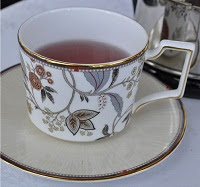 Tea is served with warm milk, sugar, lemon, and honey. Hot water is brought to the table in a ceramic jug along with decorative tins of various tea leaves. First, the teapot is rinsed out with hot water to warm the pot. Tea is spooned in, one for each cup of tea plus one for the pot. Appropriate quantity of hot water is poured in and the teapot's covered with a decorative, quilted tea cozy. The tea's allowed to steep for 5–7 minutes, after which it is carefully strained into each cup.
Tea is served with warm milk, sugar, lemon, and honey. Hot water is brought to the table in a ceramic jug along with decorative tins of various tea leaves. First, the teapot is rinsed out with hot water to warm the pot. Tea is spooned in, one for each cup of tea plus one for the pot. Appropriate quantity of hot water is poured in and the teapot's covered with a decorative, quilted tea cozy. The tea's allowed to steep for 5–7 minutes, after which it is carefully strained into each cup. The meal's rounded out with sweet pastries, such as jam tarts, mince pies, pecan tartlets, fruit flan, madeleines, raspberry linzers, cheesecakes, lemon bars, shortbread biscuits, custard kisses, sponge cakes, frosted fairy cakes, etc.
The meal's rounded out with sweet pastries, such as jam tarts, mince pies, pecan tartlets, fruit flan, madeleines, raspberry linzers, cheesecakes, lemon bars, shortbread biscuits, custard kisses, sponge cakes, frosted fairy cakes, etc.

 Casual users find the OED conservative, elitist, and out-of-touch with ordinary language. Not only are everyday words not entering the lexicon in real time, those words may not even make it into the lexicon, because by the time the dictionary gets overhauled, the words are no longer in popular memory. History is lost.
Casual users find the OED conservative, elitist, and out-of-touch with ordinary language. Not only are everyday words not entering the lexicon in real time, those words may not even make it into the lexicon, because by the time the dictionary gets overhauled, the words are no longer in popular memory. History is lost.



 Returning to blogging after a hiatus of three months makes this post about procrastination even more relevant. I've been reading about ways to get more efficient in how I use my time. The end of the year and then again in August before the school year begins have traditionally been the times when I re-evaluate my goals and priorities for the upcoming months.
Returning to blogging after a hiatus of three months makes this post about procrastination even more relevant. I've been reading about ways to get more efficient in how I use my time. The end of the year and then again in August before the school year begins have traditionally been the times when I re-evaluate my goals and priorities for the upcoming months. 

 Credit for
Credit for 


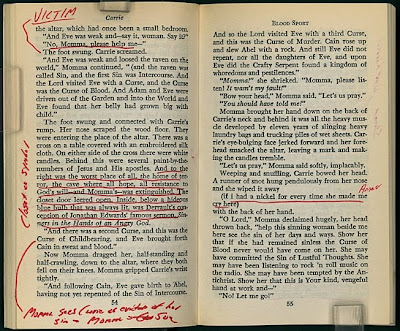

 My justification for marginalia comes from
My justification for marginalia comes from 


 "Eat a Book Today" is the motto of
"Eat a Book Today" is the motto of 
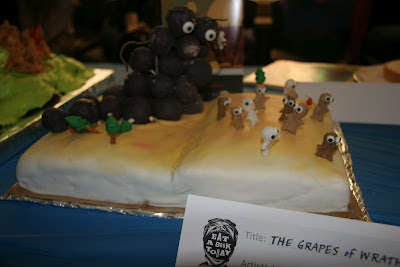




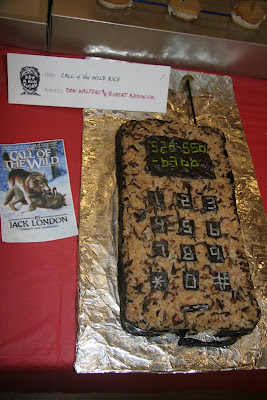


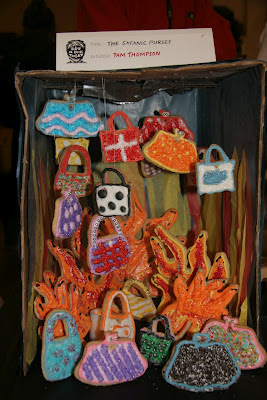
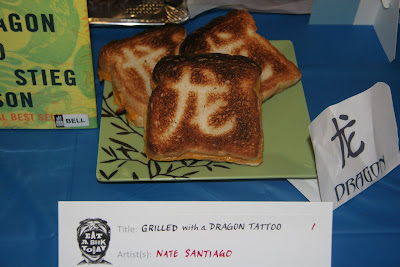



 "A toast is to a good fellow what the hole is to the doughnut—the hole doesn't mean anything off by itself. Neither does the toast. [For] a good fellow—well, a toast improves his flavor, so to speak. It's like the chap who tells you, 'My, you're looking fine!' You knew it before, but now you're sure."
"A toast is to a good fellow what the hole is to the doughnut—the hole doesn't mean anything off by itself. Neither does the toast. [For] a good fellow—well, a toast improves his flavor, so to speak. It's like the chap who tells you, 'My, you're looking fine!' You knew it before, but now you're sure." Printed in 1914 by The Reilly & Britton Co. of Chicago, The Good Fellow's Toast Book by George N. Madison, offers a collection of 400 toasts for many different occasions that a gentleman might encounter in the course of his life: bohemia, bachelorhood, drinking and conviviality, temperance, friendships, girls, love, kisses, hosts, mothers, and new years among many others. A "good fellow" here means a talented but slightly dissipated and reckless gentleman.
Printed in 1914 by The Reilly & Britton Co. of Chicago, The Good Fellow's Toast Book by George N. Madison, offers a collection of 400 toasts for many different occasions that a gentleman might encounter in the course of his life: bohemia, bachelorhood, drinking and conviviality, temperance, friendships, girls, love, kisses, hosts, mothers, and new years among many others. A "good fellow" here means a talented but slightly dissipated and reckless gentleman. The book warns gentlemen against the pitfalls of a hasty toast given in response to a hasty request: "It takes talent to make an old toast sound sincere; it takes genius to get a chuckle out of last season's joke." So..."forearmed is better than forewarned." In other words, carry this book in your coat pocket or purse and consult it frequently.
The book warns gentlemen against the pitfalls of a hasty toast given in response to a hasty request: "It takes talent to make an old toast sound sincere; it takes genius to get a chuckle out of last season's joke." So..."forearmed is better than forewarned." In other words, carry this book in your coat pocket or purse and consult it frequently. When turkey's on the table laid,
When turkey's on the table laid, A wedding is the only function which can't go off smoothly unless there is a hitch in the proceedings.
A wedding is the only function which can't go off smoothly unless there is a hitch in the proceedings.